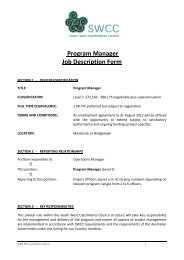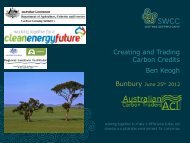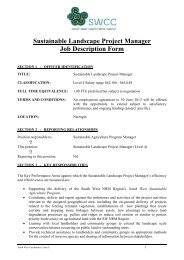Tender for the Programme - South West Catchments Council
Tender for the Programme - South West Catchments Council
Tender for the Programme - South West Catchments Council
You also want an ePaper? Increase the reach of your titles
YUMPU automatically turns print PDFs into web optimized ePapers that Google loves.
DRAFT<br />
<strong>South</strong> <strong>West</strong> Regional NRM Strategy – Ancillary Document<br />
conditions. It is essential to build and employ effective mechanisms <strong>for</strong> observing and listening to what is<br />
going on in <strong>the</strong> competitive environment. Real-time in<strong>for</strong>mation, in turn must feed on-going strategic and<br />
operational shifts and deployments.<br />
3. Effective strategy results from <strong>the</strong> varied input of a diverse group of thinkers.<br />
Moreover, participants in strategic decision-making must be unafraid to state contrary opinions. In Doris<br />
Kearns Goodwin’s excellent book Team of Rivals, she explains how instead of bringing in a cadre of<br />
leaders whose thinking closely matched his own, Lincoln made a point of surrounding himself with his<br />
political rivals, naming William H. Seward, Salmon P. Chase, Edwin M. Stanton, and Edward Bates – all of<br />
whom had opposed Lincoln in a bitterly fought presidential race – as members of his cabinet. Despite<br />
initial misgivings, this unlikely team learned that Lincoln valued <strong>the</strong>ir opinions, would consider and reflect<br />
on <strong>the</strong>ir disagreements and challenges, and would not stick unnecessarily to preconceived notions.<br />
Though <strong>the</strong> mix of personalities and opinions inevitably led to debate and verbal conflict, Lincoln was able<br />
to facilitate and mediate, tapping into a rich variety of ideas in order to find <strong>the</strong> optimal solution to political<br />
and military issues. Goodwin attributes this ability to manage disagreement and lead an effective<br />
decision-making process as perhaps Lincoln’s greatest strength as he led a troubled nation.<br />
To ensure that your strategic team is ready to make effective decisions, look carefully in <strong>the</strong> mirror. Do<br />
you encourage debate, even argument, among your team about key decisions, or do you encourage<br />
toeing <strong>the</strong> company line Remember that <strong>the</strong> well documented occurrences of groupthink – Kennedy’s illfated<br />
bay of Pigs invasion, NASA’s decision to launch <strong>the</strong> Challenger space shuttle, Bush’s reaction to<br />
presumed weapons of mass destruction in Iraq – occur not because of oppressive or stifling leaders.<br />
Ra<strong>the</strong>r, groupthink tends to occur when leadership groups enjoy collegial and fond relationships, leaving<br />
deliberants unwilling to rock <strong>the</strong> boat, or to voice contrary opinions.<br />
4. An effective strategy follows a thorough and deep analysis of both <strong>the</strong> external environment<br />
and <strong>the</strong> internal capabilities of <strong>the</strong> organization.<br />
This is <strong>the</strong> essence of <strong>the</strong> famous SWOT model (Strengths, Weaknesses, Opportunities and Threats).<br />
The strategist must understand <strong>the</strong> effects and dynamics of external entities such as competitors,<br />
suppliers, regulators and strategic partners. A sound assessment of <strong>the</strong>se external factors leads to a rich<br />
understanding of threats to ward off and opportunities to pursue. The strategist must also understand <strong>the</strong><br />
internal capabilities of his or her organization. A realistic self-assessment enables <strong>the</strong> organization to<br />
leverage <strong>the</strong> strengths of <strong>the</strong> organization and to shore up areas of weakness.<br />
To take advantage of intelligence gained through a SWOT analysis, <strong>the</strong> strategist must ensure that<br />
intelligence does not sit idle, but is immediately mined <strong>for</strong> insight that can be used in strategic and<br />
operational decision-making. All historical stories of <strong>the</strong> great strategic achievements of history – from D-<br />
Day and <strong>the</strong> Normandy invasion to Napoleon’s greatest campaigns – include anecdotes of decisionmakers<br />
poring over maps and data and striving to find <strong>the</strong> optimal course of direction and events.<br />
5. An effective strategy identifies areas of Competitive Advantage<br />
Writing in The Art of Wart of War some 2,500 years ago, Sun Tzu postulated two dialectic <strong>for</strong>ces: Zheng<br />
is <strong>the</strong> “ordinary” element that fixes <strong>the</strong> enemy in place. Qi is <strong>the</strong> unexpected and devastating blow. Qi is<br />
indirect, unorthodox, and extraordinary. Qi does not work, though, unless Zheng is able to hold <strong>the</strong><br />
opponent in place until <strong>the</strong> decisive blow is struck.<br />
To put this in <strong>the</strong> context of today’s competitive dynamics, understand that many aspects of business must<br />
be held at parity across a wide swipe of <strong>the</strong> competitive landscape. In business, this is called <strong>the</strong><br />
“business essential” elements of organizational design. You don’t need to be world class at mundane<br />
business practices that are not your distinctive competence, but you must maintain standards of work<br />
3






